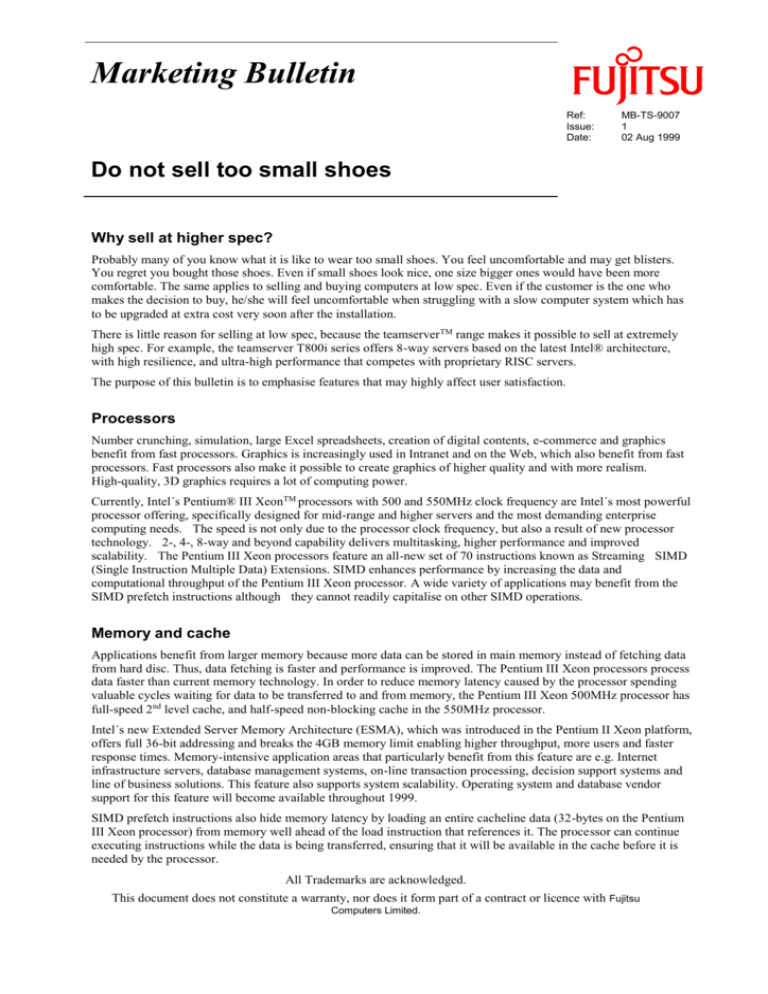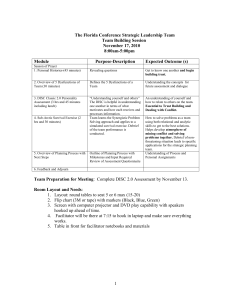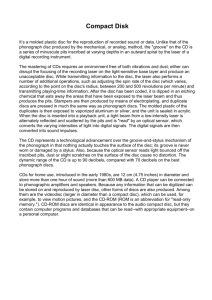Document Template - Fujitsu Technology Solutions
advertisement

Marketing Bulletin Ref: Issue: Date: MB-TS-9007 1 02 Aug 1999 Do not sell too small shoes Why sell at higher spec? Probably many of you know what it is like to wear too small shoes. You feel uncomfortable and may get blisters. You regret you bought those shoes. Even if small shoes look nice, one size bigger ones would have been more comfortable. The same applies to selling and buying computers at low spec. Even if the customer is the one who makes the decision to buy, he/she will feel uncomfortable when struggling with a slow computer system which has to be upgraded at extra cost very soon after the installation. There is little reason for selling at low spec, because the teamserver TM range makes it possible to sell at extremely high spec. For example, the teamserver T800i series offers 8-way servers based on the latest Intel® architecture, with high resilience, and ultra-high performance that competes with proprietary RISC servers. The purpose of this bulletin is to emphasise features that may highly affect user satisfaction. Processors Number crunching, simulation, large Excel spreadsheets, creation of digital contents, e-commerce and graphics benefit from fast processors. Graphics is increasingly used in Intranet and on the Web, which also benefit from fast processors. Fast processors also make it possible to create graphics of higher quality and with more realism. High-quality, 3D graphics requires a lot of computing power. Currently, Intel´s Pentium® III XeonTM processors with 500 and 550MHz clock frequency are Intel´s most powerful processor offering, specifically designed for mid-range and higher servers and the most demanding enterprise computing needs. The speed is not only due to the processor clock frequency, but also a result of new processor technology. 2-, 4-, 8-way and beyond capability delivers multitasking, higher performance and improved scalability. The Pentium III Xeon processors feature an all-new set of 70 instructions known as Streaming SIMD (Single Instruction Multiple Data) Extensions. SIMD enhances performance by increasing the data and computational throughput of the Pentium III Xeon processor. A wide variety of applications may benefit from the SIMD prefetch instructions although they cannot readily capitalise on other SIMD operations. Memory and cache Applications benefit from larger memory because more data can be stored in main memory instead of fetching data from hard disc. Thus, data fetching is faster and performance is improved. The Pentium III Xeon processors process data faster than current memory technology. In order to reduce memory latency caused by the processor spending valuable cycles waiting for data to be transferred to and from memory, the Pentium III Xeon 500MHz processor has full-speed 2nd level cache, and half-speed non-blocking cache in the 550MHz processor. Intel´s new Extended Server Memory Architecture (ESMA), which was introduced in the Pentium II Xeon platform, offers full 36-bit addressing and breaks the 4GB memory limit enabling higher throughput, more users and faster response times. Memory-intensive application areas that particularly benefit from this feature are e.g. Internet infrastructure servers, database management systems, on-line transaction processing, decision support systems and line of business solutions. This feature also supports system scalability. Operating system and database vendor support for this feature will become available throughout 1999. SIMD prefetch instructions also hide memory latency by loading an entire cacheline data (32-bytes on the Pentium III Xeon processor) from memory well ahead of the load instruction that references it. The processor can continue executing instructions while the data is being transferred, ensuring that it will be available in the cache before it is needed by the processor. All Trademarks are acknowledged. This document does not constitute a warranty, nor does it form part of a contract or licence with Fujitsu Computers Limited. Marketing Bulletin Do not sell too small shoes MB-TS-9007 Issue 1 Page 2 of 3 Storage systems Hard discs in servers are business-critical, and will be even more so in the future. Today´s Intranet and Internet implementations, large database systems, business intelligence and e-commerce require a lot of storage capacity. Every new version of application software and operating systems include new features and usually require more disc and memory space than previous versions. Enterprises tend to collect more and more information for business intelligence in order to be able to choose the right business strategies and get competitive advantage. End-users download piles of data from the Internet. RAID disc systems are often used in servers to ensure performance and data integrity. For optimum space usage, the discs in a disc array should be of the same size, which means that all the discs in an array should be upgraded if disc upgrade is required. Therefore, it is worth choosing a future-proof disc configuration. Because the RAID systems use redundant data to ensure data integrity, additional storage capacity must be available for the redundant data. The capacity needed for redundant data depends on the file sizes of actual data and the RAID level used. All approved RAID levels are supported for internal discs in the teamserver range, except for the A800i series. RAID levels 0, 1, 1/0 and 5 are supported for the teamserver FibreChannel Storage System. Backup Fujitsu offers tape drives for backup purposes. In spite of the data integrity offered by RAID systems and hot-swap discs, regular backup to tape should not be neglected. RAID level 0 is not a true RAID level, but a non-redundant striped array with no fault tolerance that offers performance advantage over single disc due to parallel disc I/O. Tape backup is crucial for server configurations not using RAID systems. Tape is also a cost-effective media for archiving data, or for storage of rarely used data. Reliability and resilience Enterprises run mission-critical applications, which means that downtime causes lost work, lost business opportunities, additional costs and maybe lost data. In addition, the number of companies with global operations and business contacts increases, which emphasises the need for 24-hour communications 7 days a week. The teamserver range offers all opportunities to create fault-tolerant server systems. Error Correction Code for memory and system bus is a reliability feature required of enterprise servers. Support for approved RAID levels makes it possible to choose the optimum level for different environments. RAID level 0 offers performance advantage over single disc systems, while RAID level 1 uses complete, identical copies of disc contents by mirroring discs. Thus, constant data availability is guaranteed if a drive one failure occurs. This solution requires doubled disc capacity. Hot-swap, redundant critical components, such as discs, power supplies, fans and network cards, can be replaced without downtime while the secondary component takes over the task in case of a failure. Some teamserver configurations support such features. There is no need for big stock of redundant components, if they can be used throughout the installed park. Fujitsu® offers Microsoft® Cluster Server (MSCS) and teamserver FibreChannel Storage System as a cluster solution for teamserver C800i, G800i, L800i and M800i configurations for optimised disc performance and minimised server downtime. In clustering, two or more servers (or nodes) are linked together to provide a single resource on which to run mission-critical applications. More than one server can access a common set of resources. Users interact with a cluster as if it were a single large server. Clustering is nothing new, but until recently, it has been a privilege of very large companies with budgets for very expensive, proprietary equipment. The failure of a node, or a component within a node, can be detected by the clustering software and mission-critical applications can be restarted elsewhere on the cluster. Restarting a mission-critical application may mean a break in user service, but the break is kept to a minimum – usually in the order of minutes. Microsoft Cluster Server is a built-in feature of Windows NT Server, Enterprise Edition. MSCS supports connection of two servers into a cluster for higher availability and easier manageability of data and applications. MSCS can automatically detect and recover from server or application failures, and enables planned maintenance without downtime. Clustering offers scalability, availability and easier manageability. Scalability comes by aggregating servers to spread the workload. Availability means that if one server within the cluster should fail, the other(s) carry on, with no work lost, while the failed server´s workload is distributed among the surviving nodes. Users do not care where the data is stored or where the processing takes place. Marketing Bulletin Do not sell too small shoes MB-TS-9007 Issue 1 Page 3 of 3 Servermanager Assist Pro is a product for pro-active server monitoring and alerting. Servermanager Assist Pro is available for teamserver G800i, L800i and M800i series. Servermanager Assist Pro performs real-time monitoring and alerting of critical hardware and operating system attributes such as memory utilisation, disc drive status, and network adapter transmission errors. Among other features, it also monitors environmental parameters such as voltage, on-board/off-board temperatures, and handles server power on, power off, operating system shutdown and reboot – regardless of server state. It can redirect Windows NT and NetWare server´s video, keyboard and mouse I/O to the administrator´s Windows-based workstation over the network, from the time the machine is switched on. Intel Remote Management Card is required for connection via a network or external modem, when the server has lost power. Manageability Intel´s MS440GX motherboard is used for the Intel Pentium III Xeon processor. The MS440GX is compliant with the Wired for Management (WfM) initiative to improve manageability. The product design includes instrumentation to monitor system health, facilities to perform service boot routines and advanced power management. Servermanager Assist Pro is available for pro-active server monitoring and alerting, which highly improves system manageability. The RAID SCSI controllers available for the teamserver range also support advanced monitoring features. Solutions based on ErgoWin Thin Clients offer excellent manageability and security. Redundant and hot-swap critical components Redundant and hot-swap critical components minimise downtime in case of a component failure. With redundant components, the secondary component can take over if the primary component fails. Hot-swap components refer to components that can be replaced without downtime. For example, discs may be hot-swap discs. In case of a disc failure, the faulty disc can be replaced without downtime. This feature is utmost useful in RAID configurations. With two hot-swap network cards continuous network connection can be maintained, if the primary network card fails. The secondary network card takes over, and the faulty card can be replaced without downtime. Even in a large installation there is no need for a big stock of spare network cards, if all the installed servers use the same network card. Scalability If servers are bought at low spec, need for upgrade may emerge very soon. Later upgrades will cause higher total costs than buying at higher spec from the beginning. The higher cost is due to higher prices for separate upgrade kits compared to pre-installed components, hardware installation cost, downtime (=lost productivity), support cost for software installation, setting changes and testing. In addition, prices do not always go down by the time. On the contrary, costs for later upgrade kits may go up, and availability may become a problem, because new technology emerges faster and faster. Even if the system would show sufficient performance and resources at installation, there may be need for upgrades in the future. Higher requirements may be caused by an increased number of users on the network, more load on the system, or new applications installed. In this situation a scalable system will save earlier investments and still allow adding performance and resources. For example, processors, hard discs or memory may be added. Future-proof server systems and lower TCO Buying the latest technology and scalable systems with high level of manageability is a future-proof decision, which also minimises total cost of ownership (TCO). The teamserver range gives the opportunity. Take it. For the Customer´s best, sell at high spec, but with headroom!






